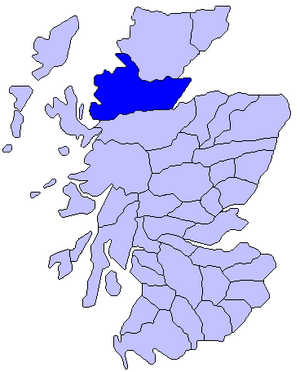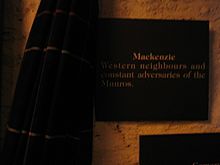Battle of Bealach nam Broig facts for kids
Quick facts for kids Battle of Bealach nam Broig |
|||||||
|---|---|---|---|---|---|---|---|
| Part of the Scottish clan wars | |||||||
 Ben Wyvis seen from the west. Carn Mòr is the smaller hill on the far left, the pass lies between the two. |
|||||||
|
|||||||
| Belligerents | |||||||
| Allies of the Earl of Ross: Clan Munro Dingwall family Clan Fraser of Lovat |
Septs of Clan Mackenzie: Clan MacIver Clan Macaulay Clan MacLeay Clan MacLennan |
||||||
| Commanders and leaders | |||||||
| George Munro, 10th Baron of Foulis † William Dingwall, Baron of Kildun † Hugh Fraser, 1st Lord Lovat |
Supporters of Alexander Mackenzie, 6th of Kintail: Donald Garbh MacIver Duncan Macaulay. |
||||||
| Strength | |||||||
| Unknown | Unknown | ||||||
| Casualties and losses | |||||||
| According to Sir Robert Gordon (1630): "lost a great number of men" According to George Mackenzie, 1st Earl of Cromartie (1669): Munro of Foulis and 3 sons killed According to Alexander Mackenzie (1894): 140 Dingwalls killed 11 Munros killed |
According to Sir Robert Gordon (1630): "Utterly Extinguished" According to George Mackenzie, 1st Earl of Cromartie (1669): All 26 men killed According to Alexander Mackenzie (1894): "Extirpated" (Extinct) |
||||||

The Battle of Bealach nam Broig (which means "Pass of the Brogue" in Scottish Gaelic) was a major fight between different Scottish clans. It took place in the lands of north-west Ross. Clans from this area fought against clans from north-eastern Ross who supported the Earl of Ross. Historians disagree on the exact date of the battle. It most likely happened in 1452, but some old records suggest it could have been as early as 1299.
Contents
Where the Battle Happened
Bealach nam Broig is a mountain pass located about 20 miles northwest of Inverness. It's in the area of Fodderty, near the A835 road that leads towards Ullapool. The pass is nestled between the tall ridge of Ben Wyvis and a smaller hill called Carn Mòr. It overlooks a loch named Loch Bealach Cùlaidh. The area is known for its rugged, mountainous terrain.
Clues from the Past
In 1913, an old arrowhead was discovered near where the battle is thought to have taken place. This finding helps confirm that a conflict did happen in this area long ago.
Stories of the Battle
Historians have written different accounts of the Battle of Bealach nam Broig over the centuries. These stories often agree on the main events but sometimes differ on the exact dates, who was involved, and how many people were hurt.
Early Accounts (1600s)
Some of the first written stories about the battle come from the 17th century.
Sir Robert Gordon's Story (1630)
Sir Robert Gordon wrote one of the earliest accounts around 1630. He said the battle happened around 1275, but another book based on his work suggested 1299.
According to Gordon, some highland clans like the MacIvers, MacAulays, and MacLeays rebelled against the Earl of Ross. The Earl captured their leader and put him in Dingwall Castle. To get their leader back, the rebellious clans captured the Earl's second son at Balnagown.
The Munros and Dingwalls chased the rebels and caught them at Bealach nam Broig. A fierce battle broke out. Gordon wrote that the MacIvers, MacAulays, and MacLeays were almost completely wiped out. The Munros and Dingwalls won, but it was a "hollow victory" because they lost many of their own men. He claimed 140 Dingwalls and 11 Munros from the Foulis family were killed, leaving a baby as the next in line for the Munro chief.
Mackenzie Family Stories (1669)
Two Mackenzie historians, George Mackenzie and John Mackenzie of Applecross, wrote their own versions around 1669. They placed the battle after the Battle of Harlaw in 1411.
George Mackenzie said a Mackenzie leader was captured by the Earl of Ross. In response, Mackenzies captured the Laird of Balnagowan. The Munros then chased the Mackenzies. He stated that 26 Mackenzie men were killed, while George Munro of Foulis and his three sons also died. The Mackenzies used their captive to get their leader freed.
John Mackenzie of Applecross's story was similar. He said a leader named Duncan MacAulay led the Kinlochewe men. MacAulay used a clever trick with arrows to defend a pass. He also used his prisoner to bargain for the release of his master, who was a Mackenzie.
Other 17th Century Accounts
- The Letterfearn Manuscript (around 1670) tells a more mythical story. It suggests a Countess of Ross wanted to marry a Mackenzie. This story is less likely to be true because of the dates of the countesses.
- The Wardlaw Manuscript (1674) by James Fraser said the battle happened in 1374. It also described the capture of the Earl's son and the heavy losses for the Munros and Dingwalls.
- George Martine (late 1600s) wrote about the battle, giving two different dates: 1299 and 1452. The 1452 date became more widely accepted later.
Later Publications (1800s - 1900s)
Historians in the 19th and 20th centuries continued to research and publish about the battle.
John Anderson's View (1825)
John Anderson wrote about the battle in 1825. He said it happened in 1374. He described how the Earl of Ross captured Donald Garbh MacIver, leading to the rebels capturing the Earl's son. The Lord Lovat and forces from the Dingwalls and Munros then fought the rebels at Bealach nam Broig. Anderson noted that the Dingwalls and Munros won, but at a high cost, with many casualties including their leaders.
Alexander Mackenzie's Research (1894/1898)
Alexander Mackenzie, a well-known historian, strongly believed the battle took place in 1452. He used old documents to support this date. If 1452 is correct, the Earl of Ross at the time would have been John of Islay, Earl of Ross, who was also the powerful Lord of the Isles.
Mackenzie's account says the battle started when Donald Garbh MacIver tried to seize the Earl of Ross. MacIver was captured and put in Dingwall Castle. Then, Mackenzie's followers, including MacIvers, MacLennans, MacAulays, and MacLeays, freed him. They then captured Alexander Ross of Balnagown, a relative of the Earl.
The Earl of Ross asked for help from the Lord Lovat (chief of Clan Fraser of Lovat). Lovat sent 200 men, who joined the Munros and Dingwalls. This combined force caught the western clans at Bealach nam Broig. Mackenzie stated that the western clans were almost completely destroyed. All 140 Dingwalls were killed, and 11 leading men of the Munro family of Foulis also died.
R. W. Munro's Analysis (1969/1978)
R. W. Munro, a historian of the Munro clan, pointed out in 1969 that there are no records of the battle from the actual time it happened. The earliest accounts are from the 1600s. He also noted that some of the evidence used by earlier historians was not as strong as it seemed. While 1452 fits well with the Munro family history, Munro suggested that 1369 could also be a possible date based on some Mackenzie sources.
In 1978, R. W. Munro published a book that included a Munro family tree from 1734. This tree mentioned that George Munro of Foulis was killed at the battle. However, it didn't include the famous story about 11 Munros dying and the succession going to a baby. Munro confirmed that George Munro of Foulis was indeed dead by 1453, which supports the 1452 battle date.
The "Pass of the Brogue" Legend
There's a fun, mythical story about how the battle got its name, "Pass of the Brogue." It tells of a battle between the Mackenzies and the Dingwalls. The Mackenzies were greatly outnumbered but won with the help of a little old man (a bodach).
Before the battle, the old man told the Mackenzies to wear their left shoe (brogue) on their right foot and their right shoe on their left foot. Because they followed this strange advice, the Mackenzies were able to defeat all the Dingwalls. This legend explains the unusual name of the pass.



